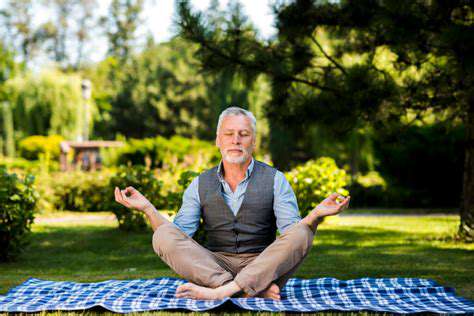Coping Strategies for Anxiety When Alone
Grounding Techniques for Immediate Relief
Deep Breathing Exercises
Deep breathing exercises are a simple yet powerful tool for calming your nervous system and reducing anxiety. When you're feeling overwhelmed, your breath often becomes shallow and rapid. Slowing down your breathing rate can have a significant impact on your overall state of mind. Inhale deeply through your nose, filling your lungs completely, and then exhale slowly through your mouth, focusing on releasing tension with each breath. Practice this technique for several minutes, paying attention to how your body responds. Regular practice can significantly reduce feelings of anxiety and promote a sense of calm.
There are various types of deep breathing techniques, including box breathing. Box breathing involves inhaling for a count of four, holding your breath for a count of four, exhaling for a count of four, and holding your breath again for a count of four. This rhythmic pattern can be incredibly helpful in grounding yourself and reducing feelings of panic. Experiment with different techniques to find what works best for you.
Mindful Awareness
Mindful awareness involves paying attention to the present moment without judgment. By focusing on your senses—the sights, sounds, smells, tastes, and textures around you—you can anchor yourself in the here and now, preventing your mind from wandering to anxious thoughts and worries. Notice the feeling of your feet on the floor, the warmth of the air on your skin, or the taste of your food. This act of conscious awareness can help reduce the intensity of anxiety and promote a sense of peace and stability.
Progressive Muscle Relaxation
Progressive muscle relaxation is a technique that involves systematically tensing and relaxing different muscle groups in your body. This process helps you become aware of physical tension and release it, which can often be a significant contributor to anxiety. Start by tensing a muscle group, like your hands, for a few seconds, and then release the tension, noticing the difference between the tense and relaxed state. Move through different muscle groups, from your toes to your head, focusing on the sensation of relaxation with each release. This technique can be incredibly helpful in reducing physical symptoms of anxiety, such as muscle aches and tension headaches.
Sensory Stimulation
Engage your senses to ground yourself in the present moment. This can involve anything from smelling essential oils, to listening to calming music, to touching a comforting object, like a soft blanket or a smooth stone. Aromatherapy with lavender or chamomile can have a calming effect. Music can also be a powerful tool for grounding. Finding a comforting object to touch can offer a physical anchor in a stressful situation. Engaging multiple senses simultaneously can be particularly effective in reducing anxiety and creating a sense of stability.
Creating a Safe and Soothing Environment for Self-Care

Creating a Calming Atmosphere
A safe and soothing environment is crucial for well-being, fostering relaxation and a sense of security. Creating this space involves careful consideration of the elements that contribute to a calming atmosphere. This can range from thoughtful décor choices to strategic lighting and sound design. A well-designed space can significantly impact mental health and emotional regulation.
Understanding the principles of color psychology and how different colors evoke different emotions is essential. For example, soft blues and greens often promote a sense of tranquility, while warm yellows and oranges can stimulate and uplift. Choosing the right colors for your space is a fundamental step in creating the desired atmosphere.
Strategic Use of Lighting
Proper lighting plays a vital role in shaping the mood and ambiance of a space. Soft, diffused lighting, such as lamps with warm-toned bulbs, can create a cozy and inviting atmosphere. Avoid harsh overhead lighting, as it can feel sterile and unwelcoming. Experiment with different light sources and intensities to find the optimal balance for relaxation and comfort.
Natural light is also incredibly important. Maximize the use of natural light sources by keeping windows unobstructed and using sheer curtains to diffuse strong sunlight. The interplay of natural and artificial light can significantly enhance the overall ambiance of the space.
Importance of Sound Design
The soundscape of a space significantly impacts the overall experience. Incorporating soothing sounds, such as gentle music or nature sounds, can create a calming environment. Conversely, loud or jarring noises can disrupt peace and increase stress levels. Carefully consider the types of sounds that resonate with your desired mood and environment.
Reducing unwanted noise is equally important. Consider noise-canceling solutions, such as soundproof curtains or white noise machines, to minimize distractions and create a tranquil space. A well-designed soundscape can have a profound impact on the overall experience within a space.
Choosing the Right Décor
Thoughtful décor choices can significantly enhance the feeling of safety and comfort. Incorporating soft textures, such as plush rugs, comfortable cushions, and cozy blankets, can contribute to a relaxing atmosphere. Choose materials that are pleasing to the touch and promote a sense of tactile comfort. Natural elements, like plants and wood accents, can also bring a sense of peace and connection to nature.
Consider the colors, patterns, and styles that resonate with your personal preferences and create a sense of harmony. Avoid overly busy or chaotic patterns, as they can be overwhelming and distracting. Instead, opt for calming and soothing colors and patterns that evoke a sense of serenity.
Maintaining a Clean and Organized Space
A clean and organized space contributes significantly to a sense of calm and well-being. Clutter can be visually and mentally overwhelming, creating feelings of stress and anxiety. Regularly decluttering and organizing your space can help create a sense of peace and control. This includes tidying up surfaces, storing items away, and maintaining a clear and uncluttered environment.
Creating a sense of order and neatness helps to reduce visual distractions and promotes a more focused and relaxed mental state. The feeling of a well-maintained space can contribute significantly to a sense of safety and security.